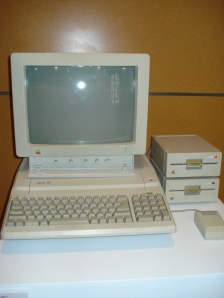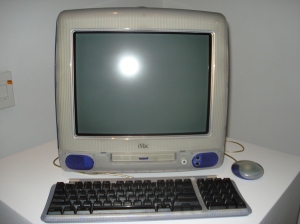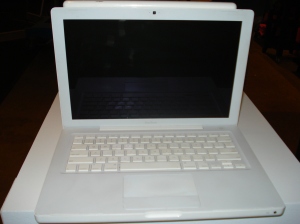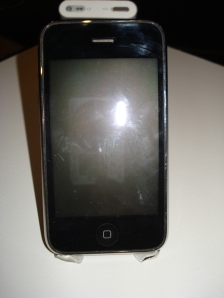As I’m sure you faithful Woolly Blog followers are aware, the remount of Mike Daisey’s The Agony and the Ecstasy of Steve Jobs is already underway. Tonight marks the opening of its three week run in our space. We are all excited to see how bringing this piece full circle will affect us, Woolly audiences, and Mike himself.
All that said; I’m happy to report that we have brought back the Apple Orchard for the run of the show… with one exciting addition! Check out what we have dusted off and are displaying in our lobby right now.
Apple IIe:

Released in January 1983 and originally sold for $1395, the Apple ][e was to be one of the most successful Apple computers ever (it was manufactured and sold for nearly 11 years with few changes). One of its defining characteristics was its ability to input and display lowercase letters for the first time. In 1984 the name was changed from Apple ][e to Apple //e, coinciding with the release of the Apple //c.
Apple ImageWriter II:

Released in September 1985 for $595, the Apple ImageWriter II was the first printer built exclusively for the Macintosh series. Because of the relatively small price and high printing speed, the ImageWriter series was extremely popular amongst consumer computer users. In 1990 the ImageWriter series was replaced by the ink-jet StyleWriter series.
Newton Message Pad:

Released in August 1993 for $800, the Newton Message Pad was Apple’s first completely new product in many years. It represented Apple’s entry into (and perhaps creation of) an entirely new market: Personal Digital Assistants (PDAs). The PDA market was barely present when the Newton was released, but other companies were working on similar devices.
The Newton Message Pad featured a variety of personal-organization applications, such as an address book, a calendar, and notes, along with communications capabilities such as faxing and email. It featured a trainable handwriting recognition engine, but unfortunately this engine was notoriously difficult to use. While later Newton models would show improved handwriting recognition, the Newton’s reputation for poor recognition would haunt it for years to come.
Apple Quicktake 200:

Released in February 1997 for $600, the Apple QuickTake was one of the first consumer digital cameras. The QuickTake 100 and 200 models were only compatible with Macintosh computers, while the 150 model was also compatible with Microsoft Windows. However, none of these models sold well because other companies such as Kodak, Canon and Nikon entered the market with brands that consumers associated with photography.
iMac (Rev. C):

Released in August 1998 for $1300, the iMac was Apple’s computer for the new millennium. Aimed at the low-end consumer market and designed with the internet in mind, the iMac was positioned by Apple as the most original new computer since the original Mac in 1984, and came in a stylish new case design, with translucent “Bondi Blue” plastics. It also included a newly-designed USB keyboard and mouse. By January 1999, the Rev. C iMac came in five bright new colors: Blueberry, Strawberry, Lime, Tangerine and Grape.
iBook G4:

Released in October 2003 for $1099, the iBook was much smaller than its predecessor, the PowerBook G4 and included a faster G3 processor, more RAM, VGA out, stereo speakers, and a higher resolution screen. It also was the first Mac to include a “combo” DVD-ROM/CD-RW drive in the high-end model.
iPod mini 4GB (Second Generation):

Released in February 2005 for $199, the iPod mini was built around a one inch 4 GB hard drive, and raised the bar for portability in a hard disk music player. It was small enough to wear comfortably on an arm band, but large enough to hold nearly 1,000 songs. Apple believed that its small size and consumer appeal would make up for its high price. As Apple hoped, iPod mini’s sold extremely well—the demand vastly outstripped the supply long into the summer months.
The iPod mini was available in five metallic colors: silver, gold, pink, blue and green. In order to fit everything in such a small package, Apple had to change the layout of the buttons from the existing iPod design. The result, which Apple called a “ClickWheel” allowed users to use the wheel as a touch-sensitive scroll wheel, or push on the four corners to click the buttons.
MacBook:

Released in May 2006 (original) for $1099, the MacBook replaced the existing 12- and 14-inch iBooks and 12-inch PowerBook model, completing the transition of Apple’s portable computers to Intel Processors. At the time it was considered one of Apple’s best computers, and around 2008 became Apple’s best selling Macintosh in history. The original MacBooks were available in black or white, and was the second (after the MacBook Pro) Mac to adopt Apple’s “MagSafe” power connector. The MacBook was Apple’s first notebook to use features now standard in its notebooks, such as the glossy display, the sunken keyboard design, and the non-mechanical magnetic latch.
iPhone 3GS:

Released in June 2009 for $199, the iPhone 3GS included both specification and feature enhancements over it’s predecessor, the wildly successful iPhone 3G. The iPhone 3GS included a higher-resolution video-capable camera, an integrated Magnetometer, and Voice Control. It shipped with iPhone OS 3.0 (which was also made available for previous iPhone and iPod Touch models), which included software enhancements, such as cut & paste, pervasive landscape keyboard, search, internet tethering, and a voice memos application. In June 2010, both models were replaced by the iPhone 4.
Stay tuned for another post coming soon about our special artifact, coming to our space on August 4th. Hint? This famed Apple product was in the news recently.
~ Melanie Harker, Connectivity Associate
{& a special shout-out to Brooke Miller, our former Press & Digital Content Manager who helped compile this original blog post!}
